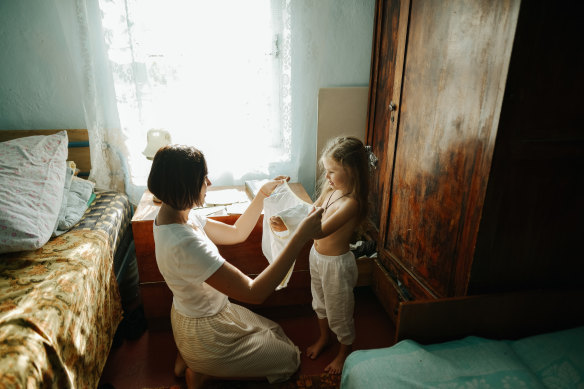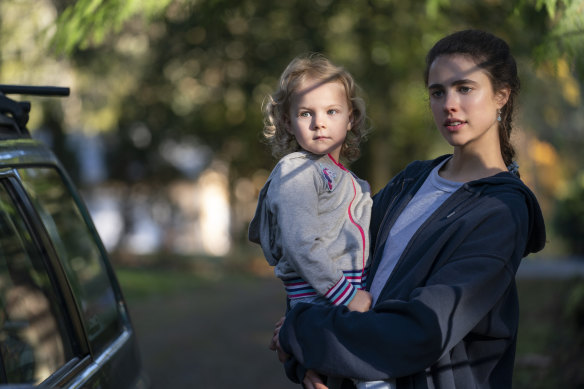This was published 3 years ago
Inside the refuges helping family violence survivors get back on their feet
By Margaret Ambrose
A taxi pulls up in an ordinary street in an outer Melbourne suburb. A woman and small child get out, carrying only a couple of plastic supermarket bags, and disappear through a narrow entrance. The taxi pulls away and the street is once again quiet. Until the next taxi pulls up.

The secrecy of refuge locations and the privacy of their clients is essential for keeping the women and their children safe from their violent partners.Credit: Stocksy
The woman’s name is Katie*. She and her seven-month-old daughter have just spent three nights in a motel and are about to enter Victoria’s newest purpose-built women’s refuge. Although now safe from the years of domestic violence perpetrated by her partner, Leo*, as she approaches the refuge, Katie has the same blank facial expression she has worn for years.
The women who come here arrive homeless and traumatised – often with physical and mental wounds – and during their six-to-eight-week stay work with specially trained professionals to rebuild their lives.
The Netflix drama Maid was the first time many of us had been given a glimpse into the inner workings of a women’s domestic violence refuge. And for good reason – the secrecy of their locations and the privacy of their clients is essential for keeping the women and their children safe from their violent partners.
Yet, while Maid has generally been applauded for its accurate depiction of the struggles faced by single mothers, its portrayal of women’s refuges could not be further removed from the reality of modern refuges.
Refuge Victoria is the largest provider of family violence refuge accommodation in Victoria, operating three high-security refuges and having access to over 50 crisis accommodation and transitional housing properties.
Tucked away in quiet suburban locations, the refuges look like any other collection of units springing up in gentrified suburbs and there’s nothing to give away the nature of the accommodation.
The refuge that Katie entered is not even visible from the street. It is a purpose-built building on a big block, and surrounded on all four sides by residential properties. The refuge has two playgrounds, a shared barbecue and outdoor dining space, and a dedicated children’s playroom. It’s fully accessible for women and children with disabilities. Each fully furnished unit has its own kitchen, bathroom and lounge room, with independent access, as well as a separate courtyard, which allows clients to bring their pets.
For Katie, that’s an important detail. She says her puppy was often a victim of her partner’s violence, and refuge staff say fear of what will happen to their pets sometimes means women are reluctant to leave their homes.

While Netflix’s Maid has generally been applauded for its accurate depiction of the struggles faced by single mothers, its portrayal of women’s refuges could not be further removed from the reality of modern refuges.Credit: Netflix
When Katie and her daughter arrive, they are taken to their unit, which is pre-stocked with groceries, the beds made up with fresh linen. For Katie’s daughter there’s new clothing, nappies and formula, along with a cot and teddy. Katie’s case manager guides her through what she can expect in terms of security, support and case management during their stay.
Refuge Victoria’s chief operating officer, Janine Sherrard, says the staff are measured in their initial interactions, as new clients can easily become overwhelmed.
“When Katie arrived, she presented as wary and reserved, but at the same time clear about the need to protect her daughter,” says Sherrard. “Like many of our clients, Katie had been pulled into a web of services, not of her own choice. For years, she’d been engaged with police, child protection and the court system because of Leo’s violence.
“Our clients are forced into a system that can be at times unrelenting, unfair, unclear and exhausting. They have had to leave their home, their friends and their community, all because of family violence.”
“Now, imagine also being Aboriginal, already traumatised as part of the stolen generations, or not speaking English, or having a disability, or being LGBTQIA. And imagine all of this on top of being physically and emotionally injured by the person you once trusted and loved. Family violence is like a hurricane – its damage is widespread and often leaves nothing in its wake.”
“Our clients are forced into a system that can be at times unrelenting, unfair, unclear and exhausting. They have had to leave their home, their friends and their community, all because of family violence.”
Katie had been in a relationship with the violent perpetrator for over 10 years. Leo had an extensive criminal record for drug offences, violence and firearms offences and Katie had reported multiple cases of violence to the police, including assault that involved punching , dragging her by her hair, and strangulation. She was also subject to sexual abuse, which would be used by Leo as a way to psychologically taunt her.
It was after a serious assault involving a hammer that police facilitated her move to the refuge. According to Refuge Victoria, the purpose of family violence refuges isn’t just to provide safe accommodation to those made homeless because of family violence, it’s also to provide specialist support. This requires collaboration with partners and community services to create a plan for a new life and to provide the pathway for getting there.
What’s not widely understood is that children and young people comprise the largest number of people in refuges. Last year, children accounted for 63 per cent of Refuge Victoria’s clients. Specialist young persons’ practitioners conduct safety, risk and needs assessments, and case planning for each child. They also work with services such as maternal and child-health nurses, paediatricians, and teachers.
According to Refuge Victoria CEO Ellen Matusko, while there has long been acknowledgement of family violence, greater investment in refuges and the construction of purpose-built facilities is relatively new.
“Refuges have provided safety and shelter to women for over four decades, but services were, generally speaking, regular homes or backyard garages, initially staffed by female volunteers,” Matusko says.
“Refuges have provided safety and shelter to women for over four decades, but services were, generally speaking, regular homes or backyard garages, initially staffed by female volunteers.”
“Facilities were often shared by multiple women and children. The upside was that they were safe and had access to food and other supports; however the environments were not conducive to recovery. Having to share with others with different lifestyles or parenting styles, and dealing with cultural or linguistic diversity, meant some women would choose to leave and return home to the perpetrator.”
Things changed in 2014, when Melbourne mother Rosie Batty stood on her front lawn the day after her son was beaten to death by his father and spoke about how family violence must be brought out of the shadows.
Australia was shocked by the death of Luke Batty, and the growing call for action on violence against women led to the 2015 Royal Commission into Family Violence and an unprecedented investment by state and federal governments in women’s refuges.
Last year, the Victorian government spent over $500 million supporting infrastructure for women escaping family violence. Meanwhile, the NSW government announced a budget of more than $480 million for the coming year, making it the single biggest investment in domestic violence prevention in the state’s history.
Importantly, the royal commission recommended that new refuges be built and that they follow what’s known as the “core and cluster” model.
“The core and cluster refuge model features multiple self-contained units on the one site, with a central and separate office,” explains Matusko, adding that providing them with their own home gives families the privacy and dignity they deserve.
“We work really hard towards making women feel special and important because we know that this has been lacking in their lives as they live with family violence.”
Almost as soon as a woman enters a refuge, work begins on answering the question: “Where is this family going to live after they leave?”
Some wish to return home, with the person responsible for the violence removed and with security measures such as cameras, lock changes and fences installed. Others, like Katie, whose safety depends on the violent perpetrator not knowing her address, will need to be assisted to find more permanent accommodation.
The reality is that some of the women who stay in refuges will return home to their partners.
“Research tells us that, on average, it can take people up to seven attempts to leave a person using violence,” says Sherrard. “Many of our clients are coercively controlled. They might not have access to money or a car, they might have had every move tracked via their mobile phone, or they may not be physically or emotionally able to leave.”
By the time Katie was ready to leave the refuge, she had private accommodation secured and had started looking for employment. She says she is now experiencing feelings she had almost forgotten existed: including confidence and optimism.
But as Katie left to start her new life, a new woman, Mawa*, arrived by taxi, her three children wrapped around her leg and that familiar blank expression on her face.
*Names have been changed.
Support is available from the National Sexual Assault, Domestic Family Violence Counselling Service at 1800RESPECT (1800 737 732).
To read more from Sunday Life magazine, click here.
Make the most of your health, relationships, fitness and nutrition with our Live Well newsletter. Get it in your inbox every Monday.